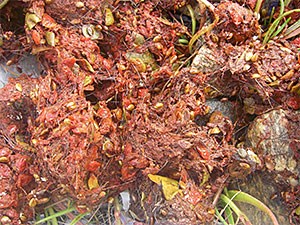Scientists use a variety of tools, some simple and some technologically advanced, to understand bear populations and their needs. Many of the same techniques can be used to answer different questions, depending on the research design and type of data collected. Here is a sample of some of the commonly used techniques, ranging from those that do not require handling the animal (non-invasive) to those that require capturing and sedating the animal to take samples and attach tags or tracking devices (invasive). These techniques are constantly being refined over time as technology advances. For example, pharmaceutical research has resulted in safer and lower amounts of drugs used for anesthesia.

NPS Photo
What goes into a bear must come out of a bear. Bear food habits are often studied by analyzing scat, or poop, as it is relatively easy to collect samples and does not require interacting with the bear. A lesson plan “The Scoop on Poop” is available as part of Glacier Bay National Park and Preserve's Middle School Scientists curriculum.
Camera TrapsMotion sensor cameras can be used to capture videos of bears’ behavior in their natural habitat. Bears alter their behavior in the presence of people, so remote cameras offer an opportunity to capture behaviors that humans rarely observe. One such camera was set up near a tree that bears use for rubbing in Glacier National Park; see a video of a black bear captured by the camera.
Aerial SurveysMuch bear habitat is remote and/or difficult for humans to access. Aerial surveys using helicopters or small aircraft allow biologists to estimate population sizes in open areas that are hard to reach. Typically a pilot flies a straight line transect for a determined distance while an observer counts the number of bears in sight for a certain distance from that line. Since the distance of the flight path and observation distance are known, researchers can obtain a population estimate of the area surveyed.

NPS Photo
Researchers use this technique to estimate population size without needing to count each bear. It is also called mark-resight, sight-resight, and capture-recapture. In traditional mark-recapture technique, bears are physically captured, marked with a tag, and released. Later, biologists return to a site or use movement-activated wildlife cameras to observe how frequently tagged bears appear.
Today recent advances in DNA technology allow biologists to estimate bear populations without putting bears through the stress of being captured. Just like humans, each bear has unique DNA. Biologists can collect DNA samples from hair and scat and use this DNA to estimate bear population size and the genetic diversity of bear populations. Samples can be collected at natural “bear rub” sites or at hair traps established by researchers. Watch a grizzly bear and her cub visit a hair trap at Glacier National Park.

NPS Photo / John Good
In some parks, you may see a bear with tags on its ears for identification and a collar around its neck. These collars emit signals that allow scientists to determine where the bear is at a given time. Telemetry refers to the process of tracking the signal and obtaining animal locations.
With radio telemetry, researchers must be relatively close to an animal to detect its presence through a receiver. This can be done on foot, from a truck, or from small aircraft or helicopters (depending on the home range of the animal). Conservation pioneers Frank and John Craighead developed the first radio collars that were used to study grizzly bears in Yellowstone National Park in the 1960s. Their efforts, both working in the field and raising public awareness, contributed to the grizzly being listed as a threatened species in 1975. Watch a video of Pat Owen, Denali National Park biologist, explaining the details of collaring grizzly bears.
Satellite/GPS telemetry has been used since the 1980s to track animals over longer distances without the researcher needing to be near the animal. Information is either stored in the collar and downloaded at the end of the study when the collar is retrieved or is transmitted to a satellite receiver or even to a cell phone! Satellite telemetry has changed the way scientists study species with large home ranges, migratory species, or species like polar bears that spend much of their time in areas that are inaccessible to people.
Often, when bears are anesthetized to attach a collar, a sample of bear tissue (such as hair or skin) will be taken. The chemical content of this bear tissue can be analyzed to determine the balance of plant and animal material in a bear’s diet. The same type of analysis can be run on archived historical samples of bones or teeth or hair samples collected non-invasively.This type of study done on samples from 1915 to 2007 in Yosemite National Park showed that the proportion of human foods in bear diets increased with park visitation until the 1990s when stringent management strategies to prevent access to human food were put in place. Today the diets of bears living in Yosemite National Park are once again similar to the diets of bears in the early 1900s.
Last updated: December 10, 2019
